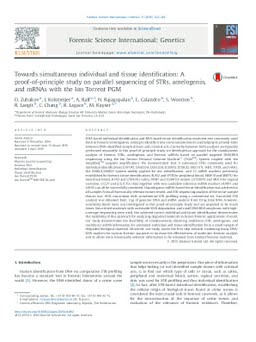2015-08-07
Towards simultaneous individual and tissue identification: A proof-of-principle study on parallel sequencing of STRs, amelogenin, and mRNAs with the Ion Torrent PGM
Publication
Publication
Forensic Science International: Genetics , Volume 17 p. 122- 128
Abstract DNA-based individual identification and RNA-based tissue identification represent two commonly-used tools in forensic investigation, aiming to identify crime scene sample donors and helping to provide links between DNA-identified sample donors and criminal acts. Currently however, both analyses are typically performed separately. In this proof-of-principle study, we developed an approach for the simultaneous analysis of forensic STRs, amelogenin, and forensic mRNAs based on parallel targeted DNA/RNA sequencing using the Ion Torrent Personal Genome Machine<sup>®</sup> (PGM™) System coupled with the AmpliSeq™ targeted amplification. We demonstrated that 9 autosomal STRs commonly used for individual identification (CSF1PO, D16S539, D3S1358, D5S818, D7S820, D8S1179, TH01, TPOX, and vWA), the AMELX/AMELY system widely applied for sex identification, and 12 mRNA markers previously established for forensic tissue identification (ALAS2 and SPTB for peripheral blood, MMP10 and MMP11 for menstrual blood, HTN3 and STATH for saliva, PRM1 and TGM4 for semen, CYP2B7P1 and MUC4 for vaginal secretion, CCL27 and LCE1C for skin) together with two candidate reference mRNA markers (HPRT1 and SDHA) can all be successfully combined. Unambiguous mRNA-based tissue identification was achieved in all samples from all forensically relevant tissues tested, and STR sequencing analysis of the tissue sample donors was 100% concordant with conventional STR profiling using a commercial kit. Successful STR analysis was obtained from 1 ng of genomic DNA and mRNA analysis from 10 ng total RNA; however, sensitivity limits were not investigated in this proof-of-principle study and are expected to be much lower. Since dried materials with noticeable RNA degradation and small DNA/RNA amplicons with high-coverage sequencing were used, the achieved correct individual and tissue identification demonstrates the suitability of this approach for analyzing degraded materials in future forensic applications. Overall, our study demonstrates the feasibility of simultaneously obtaining multilocus STR, amelogenin, and multilocus mRNA information for combined individual and tissue identification from a small sample of degraded biological material. Moreover, our study marks the first step towards combining many DNA/RNA markers for various forensic purposes to increase the effectiveness of molecular forensic analysis and to allow more forensically relevant information to be obtained from limited forensic material.
| Additional Metadata | |
|---|---|
| , , , , , | |
| doi.org/10.1016/j.fsigen.2015.04.002, hdl.handle.net/1765/86481 | |
| Forensic Science International: Genetics | |
| Organisation | Centre for Rotterdam Cultural Sociology (CROCUS) |
|
Zubakov, D., Kokmeijer, I., Ralf, A., Rajagopalan, N., Calandro, L., Wootton, S., … Kayser, M. (2015). Towards simultaneous individual and tissue identification: A proof-of-principle study on parallel sequencing of STRs, amelogenin, and mRNAs with the Ion Torrent PGM. Forensic Science International: Genetics, 17, 122–128. doi:10.1016/j.fsigen.2015.04.002 |
|

